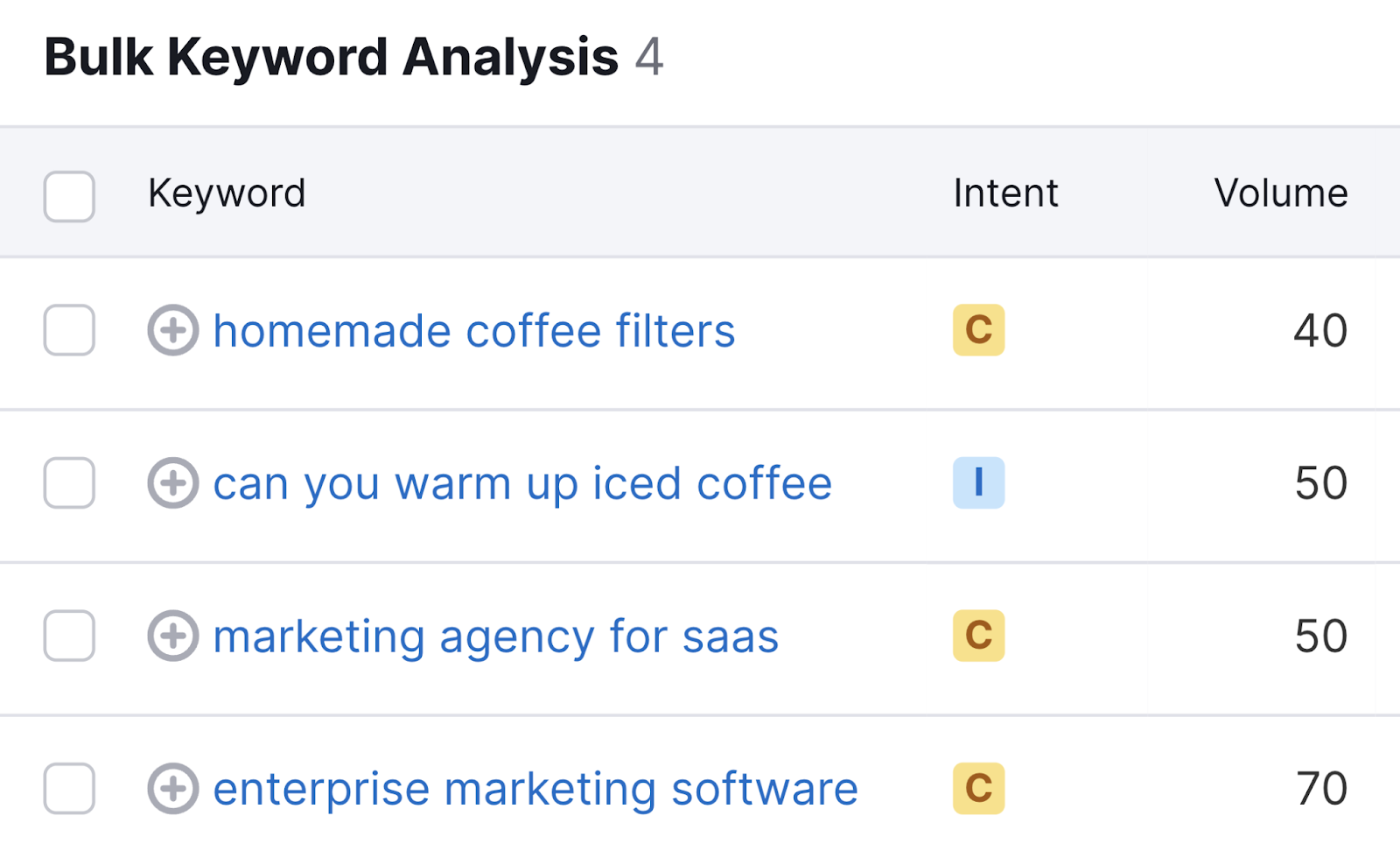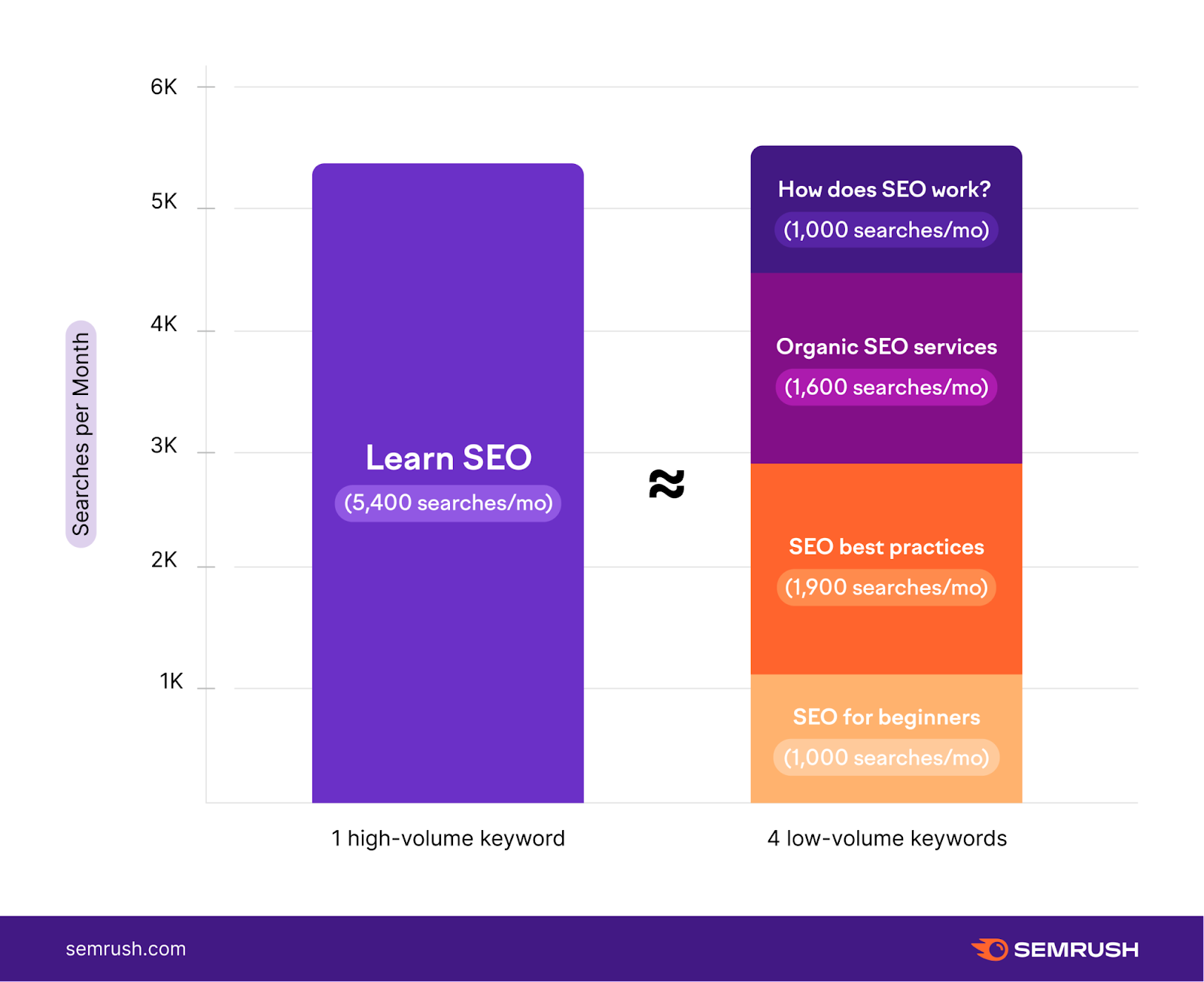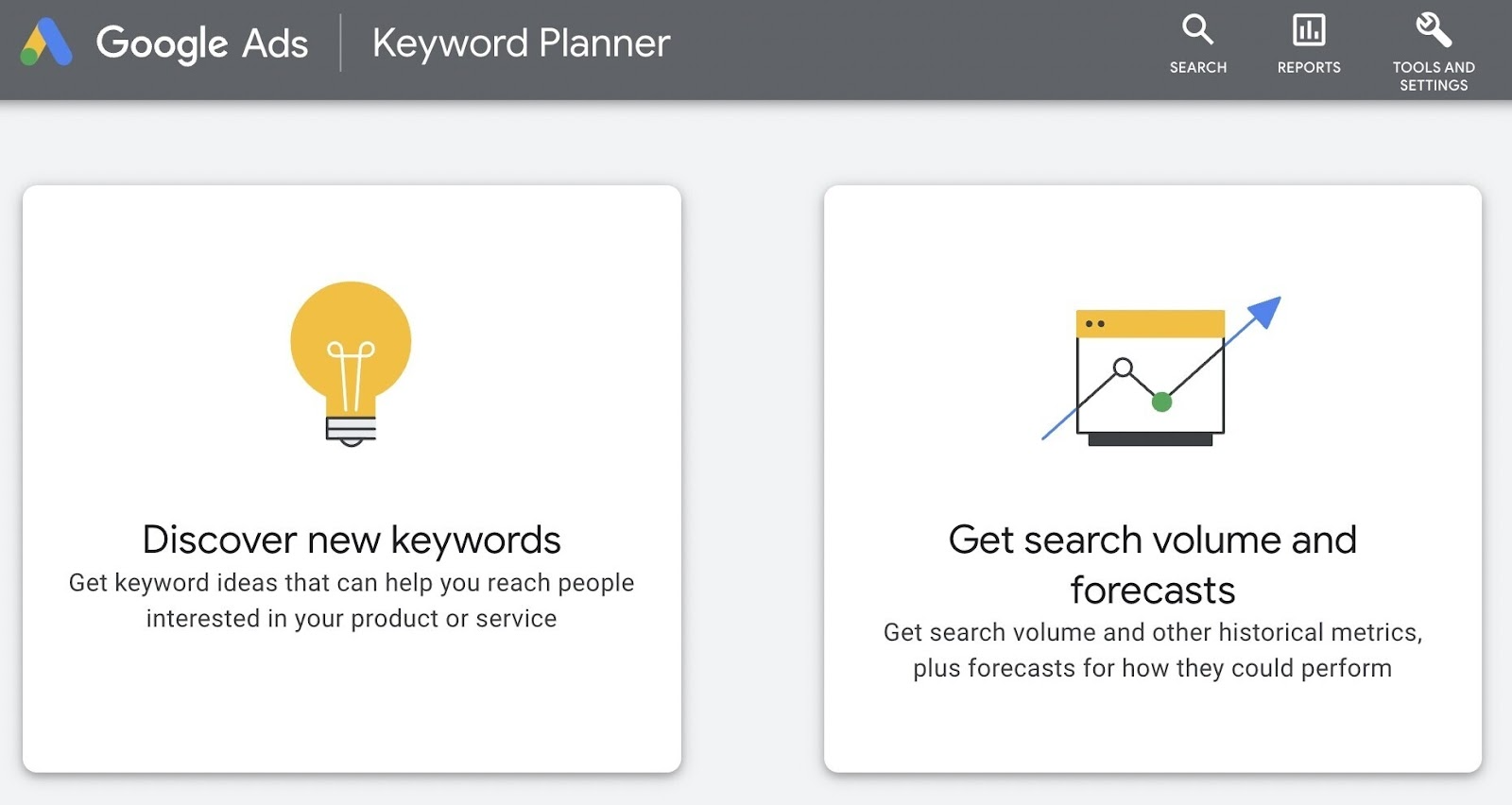What Are Long-Tail Keywords?
Long-tail keywords are longer, more specific searches that users enter into search engines.
They usually have lower search volumes individually, but collectively, they comprise a large percentage of overall searches performed on Google.
And because long-tail keywords are more specific than other types of keywords, searchers who use them may be more likely to convert—make a purchase, fill out a form, or contact you.
As illustrated below, the term "long tail" refers to the tail end of the search demand curve.

Long-Tail Keyword Examples
Here are examples of long-tail keywords:
- Homemade coffee filters
- Can you warm up iced coffee
- Marketing agency for SaaS
- Enterprise marketing software
These keywords are longer and more specific—telltale signs of long-tail keywords. They also have relatively low search volumes, according to Semrush’s Keyword Overview tool.

In contrast, these keywords aren’t long-tail keywords:
- Coffee filters
- Iced coffee
- Marketing agency
- Marketing software
The terms above are short and broad and have relatively high search volumes, so they aren’t considered long-tail keywords.

Why Are Long-Tail Keywords Important?
Easier to Rank For
Long-tail keywords are easier to rank for because they’re more specific, which leads to less competition on search engine results pages (SERPs).
Popular head terms, on the other hand, are typically very competitive, which means it can take years to rank for them with SEO, if at all.
For example, the head term “sushi” is very difficult to rank for, with a Keyword Difficulty (KD) of 93%, according to Semrush’s Keyword Overview tool.

In contrast, the long-tail keyword "sushi sandwich recipe" has a KD of 27%. Thus, this long-tail keyword is relatively easier to rank for than the related head term.

Targeted Traffic
Because long-tail keywords are very specific, the average person searching for them is probably highly interested in the topic. In some cases, the searcher is probably ready to convert.
For example, someone searching for "SEO software for small business" is likely close to a buying decision.

If you rank highly for this keyword in the SEO software space, searchers might choose to buy from you.
On the other hand, a keyword like "SEO" is very broad.

A searcher using this term is likely doing preliminary research about SEO in general and may be months away from seeking software to help with their SEO strategy.
Therefore, even if you rank for this head term, it's unlikely to bring many conversions.
Less Expensive Pay Per Click (PPC) Advertising
If you use Google Ads, long-tail keywords can help you get more value for your advertising budget.
Generally, high-volume keywords have a high cost per click (CPC). Additionally, broad keywords generally don’t convert well.
However, low-volume long-tail keywords are highly targeted, which means they can have a higher conversion rate.
They also often have a lower CPC, providing a dual benefit in PPC campaigns.
The main downside of focusing on long-tail keywords is that you need several of them to equal the amount of traffic you could get from a single head term.

Easy to Target
Because long-tail keywords are highly specific, they’re often easier to target and create content for.
For example, to target the keyword "how to filter cold brew coffee," you would create a blog post that teaches readers how to filter cold brew coffee.

Conversely, a non-long-tail keyword like "coffee grinder" is very broad. The top-ranking pages for this keyword include both ecommerce category pages and informative blog posts.

It's not clear whether you should target this keyword with a blog post about the best coffee grinders or an ecommerce category page showing all the coffee grinders you sell.
More Choice
There are more long-tail keywords to choose from compared to medium-tail keywords and head terms since long-tail keywords make up the majority of searches on Google.
When people search for information or products online, they’re more likely to use longer, descriptive phrases that reflect their specific needs or interests.
For example, a searcher would probably search for "comfortable running shoes for women with flat feet" or "basketball shoes for ankle support" over simply “shoes.”
Therefore, you’ll likely never run out of long-tail keyword ideas to target with your site.
How to Identify Long-Tail Keywords
Here are proven strategies and tips for finding long-tail keywords for your website.
Use the Keyword Magic Tool
Semrush’s Keyword Magic Tool generates thousands of long-tail keywords in seconds. It's one of the best tools for performing long-tail keyword research.
Type a broad seed keyword into the tool—short phrases or single words related to your business. These seed keywords help generate more keyword ideas and find long-tail keywords.

The tool will quickly provide different variations of your seed keyword.

The initial keywords may have high search volume and ranking difficulty, so they’re not long-tail keywords.
Narrow down the list by adding a filter to show only keywords with low ranking difficulty. Click on the "KD %" drop-down and select "Easy."

Now, you'll see a list of long-tail keyword ideas.

Perform Keyword Gap Analysis
Performing a keyword gap analysis can help you find long-tail keywords that your competitors rank for, but you don't.
Long-tail SEO keywords your competitors are targeting are likely relevant to your business as well. Therefore, targeting those keywords with your own website makes sense.
Semrush’s Keyword Gap tool can uncover your competitors’ long-tail keywords.
Open the tool, add your domain and up to four competitors, then click "Compare."

The tool will show you keywords that your competitors rank for, along with their ranking position, search volume, and keyword difficulty.

Apply filters to narrow down your results to specific long-tail keywords:
- Search volume: Filter for keywords with lower search volume
- KD %: Filter for keywords with low keyword difficulty
- Position: Filter for keywords where your competitors rank in the first 20 positions

After applying these filters, you'll see a list of long-tail keywords you can target with your own website.
Try Google Search Features
When you start typing into Google’s search box, Google's autocomplete feature will show you a drop-down list of related terms people search for.

You can also add a letter after your search term to see more suggestions. For example, typing "best content marketing p" may generate suggestions related to content marketing.

Always analyze these keywords in Semrush’s Keyword Overview tool to verify if they’re viable long-tail keywords.
For instance, analyzing "best content marketing podcasts" shows it has a low search volume and low keyword difficulty, making it a long-tail keyword.

Google also provides related searches at the bottom of the search results page.

These are usually keywords closely related to your search term but may not always be long-tail keywords. Therefore, you should analyze these keywords before deciding to target them.
Additionally, Google's "People Also Ask" box can be a source of question-based long-tail keywords.

Clicking on a question generates more related questions.

Remember to check these keywords in Semrush’s Keyword Overview tool to confirm if they're long-tail searches.
Use Semrush Topic Research Tool
The Topic Research tool helps you find topics closely related to a keyword you enter.

Many of these topics display questions related to your keyword.

These questions can be excellent long-tail keyword ideas for blog content.
Cross-check these question keywords in the Keyword Overview tool one by one.
The "Search Volume" and "Keyword Difficulty" metrics will help you decide whether to target them.

Leverage Forum Sites
Forum sites and message boards like Quora and Reddit can help you find long-tail keyword ideas.
Enter a forum site’s domain into Semrush’s Organic Research tool and click "Search."

Then, go to the "Positions" tab to see all the keywords they rank for on Google.

To find keywords related to your business, filter the report to show only those that represent your niche.
For example, if you're in the finance niche, filter the report to include keywords with the word "finance."
Navigate to "Advanced filters," type "finance," and click "Apply."

You'll then have a focused list of keywords, including long-tail variations like "is international finance hard" and "is finance a stem major."

Try Google Ads Keyword Planner
The Google Keyword Planner is designed for PPC campaigns but is also a helpful source of keyword ideas.
Log in to your Google Ads account and go to the Keyword Planner.
Select "Discover new keywords," then enter a broad seed keyword.

Then, enter a broad “seed keyword” into the field.

Google will generate related terms and show keyword search volumes.

Take the keywords with lower search volumes and analyze them in Semrush’s Keyword Overview tool. The tool will provide more data to help you determine if there are long-tail keywords worth targeting.

How to Use Long-Tail Keywords
After identifying long-tail keywords, you need to learn how to use them correctly on your page.
Here are some on-page SEO tips for long-tail keywords:
Consider the User’s Search Intent
Considering the user’s search intent means providing users with what they’re seeking.
In other words, adding your keyword to your page isn't enough. To rank highly, your content needs to satisfy the user’s search intent.
For example, to satisfy the intent of the search for "weight loss tips," create a blog post listing useful tips.
Long-tail keywords typically fall into one of four search intent categories:
- Informational intent: Users seek information (e.g., "how does your body feel after meditation?")
- Navigational intent: Users look for a specific website or page (e.g., "Apple ID account login")
- Commercial intent: Users research before purchasing (e.g., "best SEO tool for small businesses")
- Transactional intent: Users intend to make a purchase (e.g., "buy sweat suits in bulk")
Semrush’s "Intent" feature helps you identify a keyword’s search intent.

Knowing search intent allows you to create content that aligns with what the searcher is looking for.
For instance, if your long-tail keyword has informational intent, you likely need to create a blog post.
If it has transactional intent, create pages that sell your products or services, like ecommerce product pages or landing pages.
Place Your Keywords Strategically
Include your long-tail keyword in your page’s title and header tags when possible.
Use it in your first paragraph, preferably in the first sentence.
Long-tail keywords can be lengthy and may not always fit naturally into a sentence. You might need to adjust your phrasing slightly.
Ensure you're not forcing the keyword—readability and user experience are paramount.
Create Topic Clusters
Topic clusters are an effective way to organize your content for both search engines and users.
After optimizing your pages around long-tail keywords, build topic clusters by linking pages targeting long-tail keywords to pages targeting related head terms (pillar pages).

Organizing content this way helps users and search engines find information quickly, leading to increased search rankings, higher engagement, and more time spent on your site.
Optimize for Long-Tail Keywords
Long-tail keywords are ideal for new sites or those lacking authority.
If you've struggled to rank for your target terms, they may be too competitive.
Shifting your focus to long-tail keywords might be the solution.
